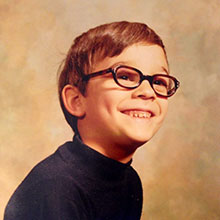
A staple of stages worldwide since its 1994 Paris debut, and now being mounted by Shotgun Players through April 12, French playwright Yasmina Reza’s ‘Art,’ is a spiky, urbane comedy aimed precisely at audiences for whom theater attendance and gallery going are requisite signifiers of class at least as much as voluntary pleasures.
That’s the same demographic represented by the play’s trio of well-to-do characters, Marc (David Sinaiko), Serge (Benoit Monin), and Yvan (Woody Harper), who find their friendship of 15 years in crisis after Serge purchases a painting by a hot contemporary artist for more than $200,000.
The canvas in question is all white.
So are the cantankerous fellows.
In light of Bay Area theater companies’ admirable efforts to represent diversity and reject white privilege on stage and in seats over the past few years, ‘Art’ feels archaic.
Seen through the lenses prescribed by our grassroots spectacle makers, this is a play about three entitled, self-centered, tunnel-visioned assholes squabbling among themselves.
The script contains not a single reference to any world wider than their rarified monochromatic milieu.
There’s little reason to get invested in the characters’ individual opinions; the men are more alike than different, more repugnant than relatable, and almost impossible to empathize with.
The Shotgun cast’s delivery of Reza’s pungent, hostile dialogue is consistently funny. But we laugh at these characters easily and dismissively, without the prickles of self-recognition and complicity that once rippled through Broadway and West End audiences.
Of course, Reza didn’t write ‘Art’ for us.
She wrote it for them. And then.
As Timothy Chalamet sings…
Deeper creakiness
Even at the time of ‘Art’’s debut, the characters’ intellectual arguments over Serge’s new painting were old hat. It was a full two decades since the publication of Tom Wolfe’s bestseller “The Painted Word,” a pithy, acidic summing up of the battle between figurative and abstract art which had raged since the early 20th century.
It’s hard to understand why Reza writes her otherwise worldly characters with no knowledge of “all white” paintings by Albers, Rauschenberg, Ryman and many others.
Marc’s outright dismissal of Serge’s purchase on the basis of aesthetics is as ignorant as parent’s suggestion that “My three-year-old could do that” in reaction Jackson a Pollock.
Revealing the undercoat
On the plus side, director Emilie Whelan explores the underpinnings of the characters’ aggression with more success than I’ve seen in other productions of “Art,” making it clear that the argument over the painting is essentially superficial.
The painting is not the real point of contention; it’s a catalyst for unarticulated jealousies, insecurities, other interpersonal conflicts to emerge.
Marc has been Serge’s mentor and role model for years. The fact that his protogée has independently begun to develop some opinions and aesthetics that are truly his own elicits feelings of abandonment, disrespect, and loss of control.
Yvan, a compulsive people pleaser and commitment-phobe is too insecure to stick to any opinion and enables both of his friends’ worst impulses. He’s long submitted to their manipulations, while leading himself to the brink of a nervous breakdown. (Harper’s performance swings from fragile to feral).
Serge, struggling with isolation after a divorce, bonds to the painting as if it were a companion, and verbally undermines Marc’s relationship with his girlfriend and Yvan’s with his fiancé. He’s also in much better financial straits than either of his friends, a subject of previously unspoken tension.
Less successfully, Whelan embellishes Reza’s crisp, efficient script with a superfluous musical prelude and interlude, as well as some awkward moments of physical comedy involving Scotch tape (An invocation of Maurizio Cattelan?).
Hitting a wall
Throughout “Art,” I was intrigued by an item displayed on Serge’s apartment wall other than the white painting: A clock with no hands.
I assumed it was intended to be another modern artwork, a functionless readymade à la Duchamp. But toward the end of the show, one of the characters asked “What time is it?”; looked directly at the clock; then declared “It’s 8:15.”
Like this 30-year-old play, the clock was not timeless.
